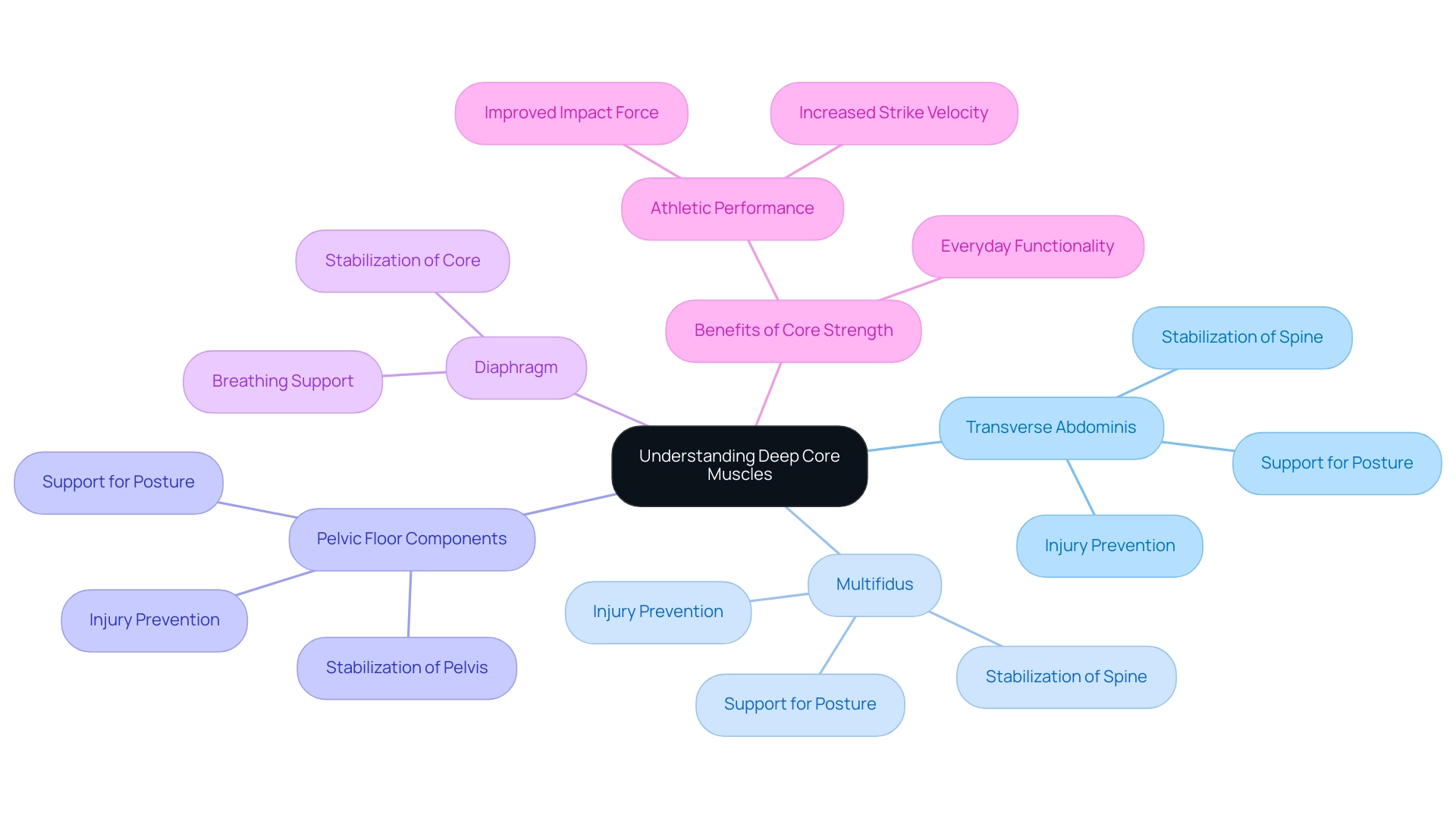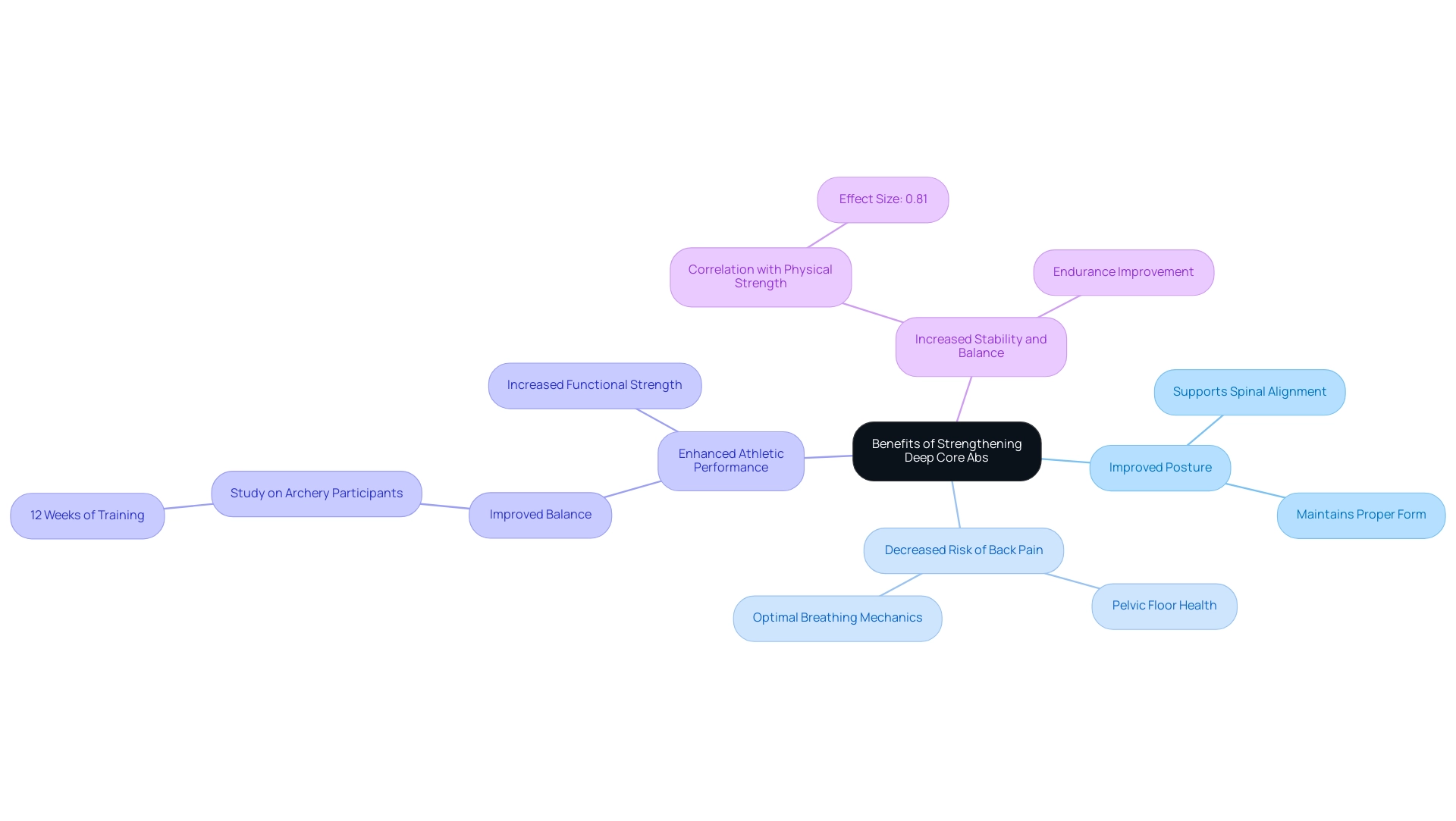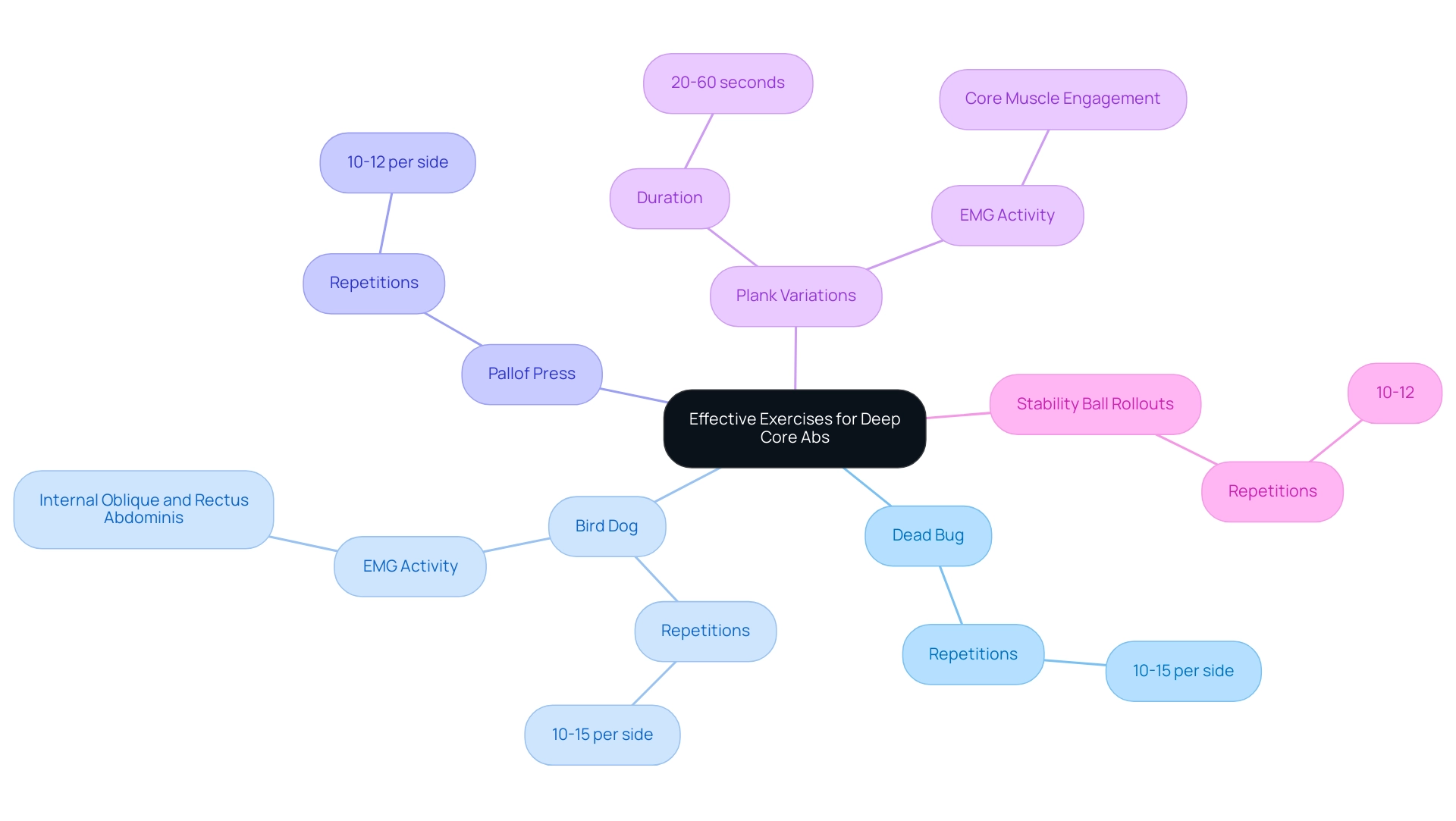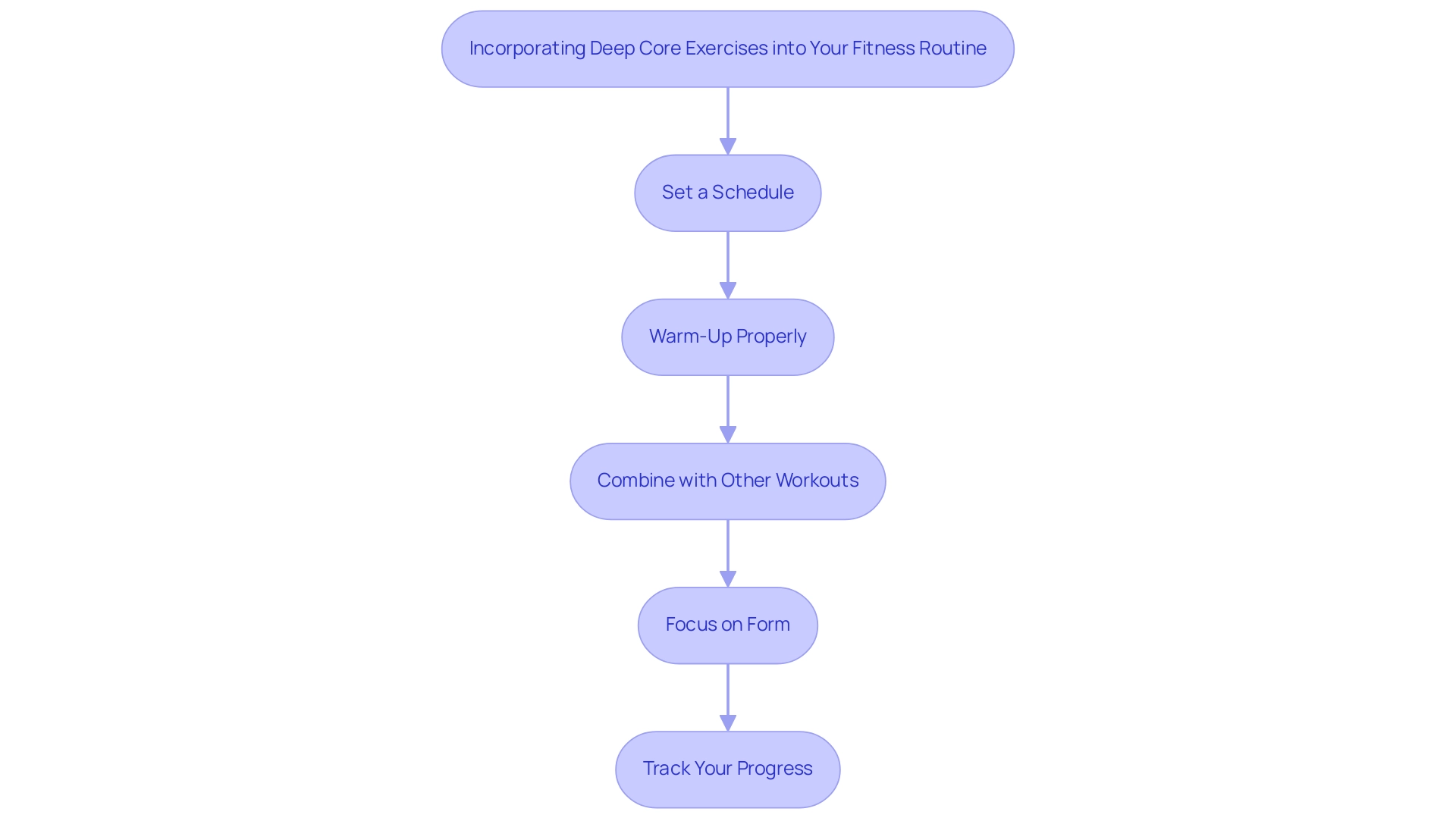Overview
The article delivers a comprehensive guide on strengthening deep core abs, underscoring their critical role in overall stability, athletic performance, and injury prevention. It effectively captures attention by detailing effective exercises and articulating the physiological benefits of deep core training. Furthermore, it presents research findings that illuminate the correlation between core strength and improved physical outcomes, making a compelling case for integrating these exercises into fitness routines. By addressing these key aspects, the article not only informs but also encourages readers to consider the essential nature of core training in their wellness journey.
Introduction
In the pursuit of optimal fitness, the significance of deep core muscles often goes unnoticed, overshadowed by the more visible superficial abs. However, these hidden powerhouses—comprising the transverse abdominis, multifidus, pelvic floor muscles, and diaphragm—are essential for stabilizing the spine and pelvis, forming the very foundation of core strength.
Recent studies reveal a troubling correlation between sedentary lifestyles and weakened core muscles, highlighting the crucial role these muscles play in preventing injury and enhancing overall physical performance. As research increasingly supports the benefits of targeted core training, understanding the anatomy and functionality of deep core muscles becomes vital for anyone looking to improve posture, balance, and athletic prowess.
This article delves into the significance of deep core strength, the myriad benefits it offers, effective exercises to incorporate into fitness routines, and practical strategies for ensuring consistent engagement with these foundational muscles.
Understanding Deep Core Muscles: The Foundation of Core Strength
The inner abdominal structures, encompassing the transverse abdominis, multifidus, pelvic floor components, and diaphragm, are crucial in stabilizing both the spine and pelvis. This foundation is essential for all physical movements, particularly in athletic contexts. Unlike the more visible external abdominal tissues often emphasized in conventional exercise routines, these inner stabilizers work quietly yet effectively to support posture and safeguard the spine against injury.
A study involving 212 healthy female participants has revealed a concerning link between central strength weakness and inactive lifestyles, highlighting that poor posture can lead to musculoskeletal disorders. The level of evidence for this study is deemed moderate, underscoring the necessity for further research in this domain. Understanding the anatomy of the deep core abs is vital for recognizing their impact on overall stability, balance, and physical performance.
Recent research underscores that effective foundational training not only enhances athletic performance—improving impact force and strike velocity in combat sports—but also plays a significant role in injury prevention, making it a fundamental component of any fitness regimen. As Eleftherios Kellis notes in his study, A Comparison between Stability Exercises and Muscle Thickness Using Two Different Activation Maneuvers, the emphasis on abdominal strength is increasingly supported by scientific evidence. This groundwork lays the foundation for improved outcomes in both athletic and everyday contexts.

The Benefits of Strengthening Your Deep Core Abs
Enhancing deep core abs provides numerous advantages that extend beyond mere appearance. Key benefits include improved posture, a decreased risk of back pain, enhanced athletic performance, and increased overall stability and balance. Research indicates a significant correlation between central training and physical strength, particularly in endurance and balance.
For instance, a study examining the effectiveness of fundamental training on balance revealed a substantial effect size of 0.81 (95% CI: 0.34–1.27), underscoring its efficacy compared to control groups. A robust core, especially strong deep core abs, not only supports spinal alignment—essential for maintaining proper form during various physical activities—but also plays a crucial role in optimal breathing mechanics and pelvic floor health, particularly post-pregnancy. Furthermore, recent findings highlight that athletes, such as archery participants, experienced marked improvements in balance after 12 weeks of progressively increasing training volume, showcasing the practical benefits of such training.
DM-G emphasizes the significance of thorough core training, stating, 'It is a foundational aspect of physical fitness that can lead to long-lasting health benefits.' Investing time in intensive workouts ultimately enhances functional strength, translating into greater efficiency in both daily tasks and athletic pursuits.

Effective Exercises to Strengthen Your Deep Core Abs
Enhancing your internal muscles is crucial for boosting stability and alleviating discomfort. Here are some effective workouts that can improve your fundamental strength:
-
Dead Bug: Begin by lying on your back with your arms extended towards the ceiling and knees bent at a 90-degree angle. Gradually lower one arm and the opposite leg towards the floor while ensuring that your back remains flat. Return to the starting position and alternate sides.
- Repetitions: 10-15 per side.
-
Bird Dog: Position yourself on all fours, maintaining a neutral spine. Extend one arm forward while simultaneously extending the opposite leg back, keeping your hips level. Hold this position briefly before returning to the starting stance. This exercise effectively activates the internal oblique and rectus abdominis, similar to findings from a case study comparing EMG activity during front plank and bilateral leg raises.
- Repetitions: 10-15 per side.
-
Pallof Press: Stand with feet shoulder-width apart, grasping a resistance band or cable at chest height. Press the band away from your chest and hold briefly before returning to the starting position. This movement effectively engages the deep core to resist rotation.
- Repetitions: 10-12 per side.
-
Plank Variations: Begin in a plank position on either your forearms or hands. Maintain this posture while keeping your midsection tight. To increase difficulty, incorporate side planks or plank leg lifts. The EMG activity observed in these variations supports their effectiveness in engaging the core muscles.
- Duration: 20-60 seconds.
-
Stability Ball Rollouts: Kneel in front of a stability ball, resting your forearms on it. Roll the ball forward while maintaining core engagement, then return to the starting position.
- Repetitions: 10-12.
Incorporating these exercises into your routine can significantly enhance your deep core strength. A recent study observed that central stabilization activities resulted in an average decrease in pain of 3.08, demonstrating their efficacy in comparison to standard therapy, which exhibited a mean reduction of 1.71. Such statistics highlight the importance of prioritizing workouts that focus on deep core abs. Additionally, case studies, such as the one comparing the EMG activity during front plank and bilateral leg raises, show that both activities activate the internal oblique and rectus abdominis effectively, making them valuable components of any training regimen. Participating in these activities not only builds strength but also contributes to overall fitness, supporting the latest trends in health and wellness. SAG did review and grant final approval of this manuscript, underscoring the credibility of the information presented.

Incorporating Deep Core Exercises into Your Fitness Routine
To effectively incorporate deep core exercises into your fitness routine, consider the following strategies:
- Set a Schedule: Aim to dedicate specific days for intense workouts, ideally two to three times a week. Research indicates that consistency is crucial for building fundamental strength and enhancing overall performance. In fact, 14 studies conducted during competition or rest periods have shown a significant impact of fundamental training on performance metrics like jumping ability, emphasizing the need for regular engagement.
- Warm-Up Properly: Always start with a thorough warm-up to prepare your body for exercise. Include dynamic stretches that specifically target your central body area. Properly warming up can enhance muscle activation and reduce the risk of injury, setting the stage for an effective workout.
- Deep core abs are essential for overall stability and strength. Combine with Other Workouts: Incorporate exercises for deep core abs into your current workout routines. For instance, consider adding a few sets of dead bugs or side planks to your strength training sessions or yoga classes. This combination not only maximizes workout efficiency but also enhances stability—a crucial element for overall fitness. The results of the case study titled "Implications for Core Stability Training" indicate that activities such as the bird dog and side plank are especially advantageous for enhancing trunk stability and assisting recovery from torso-related injuries.
- Focus on Form: Prioritize proper form over the number of repetitions. Engaging the correct muscles is essential for achieving effective results and preventing injuries. This principle is especially significant in routines like the bird dog and side plank, which have been demonstrated to enhance stability when executed properly, particularly when paired with methods such as the hollowing maneuver. As mentioned by Daniel Jerez-Mayorga, a postdoctoral researcher at the University of Granada, this study has received partial support from FEDER Agencia Andaluza de Conocimiento, highlighting the importance of structured fundamental training in rehabilitation and recreational contexts.
- Track Your Progress: Maintain a fitness journal to document your workouts, noting improvements in strength and endurance. This practice can help keep you motivated and focused on your goals, and also allows for adjustments based on your progress. Regularly reviewing your achievements can reinforce the importance of your efforts and encourage ongoing commitment.
By adopting these strategies, you can effortlessly incorporate workouts for deep core abs into your fitness routine, resulting in enhanced outcomes and better overall health. The insights from recent studies, such as those conducted by Daniel Jerez-Mayorga at the University of Granada, reaffirm the effectiveness of structured core training, particularly in rehabilitation and recreational exercise contexts.

Conclusion
Strengthening deep core muscles transcends mere aesthetics; it represents a critical investment in overall health and physical performance. These muscles are indispensable for stabilizing the spine and pelvis, enhancing posture, balance, and athletic prowess, while simultaneously reducing the risk of injury. Given the evidence linking sedentary lifestyles to core weakness, prioritizing deep core training is essential for anyone aiming to elevate their fitness levels.
Incorporating effective exercises such as:
- Dead Bugs
- Bird Dogs
- Plank Variations
into a regular workout routine can yield significant benefits. These exercises not only enhance core strength but also translate into improved performance in both daily activities and athletic endeavors. By committing to a consistent training schedule, warming up properly, and focusing on form, individuals can achieve substantial improvements in their core stability and overall fitness.
Ultimately, the journey toward stronger deep core muscles pays dividends beyond the gym. As awareness of their importance grows, so does the potential for enhanced quality of life, greater functional strength, and a reduced risk of injury. Embracing deep core training is a proactive step toward achieving better health and performance, making it a foundational aspect of any comprehensive fitness regimen.
Frequently Asked Questions
What are the inner abdominal structures and their importance?
The inner abdominal structures include the transverse abdominis, multifidus, pelvic floor components, and diaphragm. They are crucial for stabilizing the spine and pelvis, which is essential for all physical movements, especially in athletic contexts.
How do inner abdominal stabilizers differ from external abdominal tissues?
Inner abdominal stabilizers work quietly and effectively to support posture and protect the spine from injury, whereas external abdominal tissues are more visible and often emphasized in conventional exercise routines.
What did the study involving 212 healthy female participants reveal?
The study found a concerning link between central strength weakness and inactive lifestyles, indicating that poor posture can lead to musculoskeletal disorders. The evidence level for this study is considered moderate, suggesting the need for further research.
Why is understanding the anatomy of deep core abs important?
Understanding the anatomy of deep core abs is vital for recognizing their impact on overall stability, balance, and physical performance.
What role does foundational training play in athletic performance and injury prevention?
Effective foundational training enhances athletic performance by improving impact force and strike velocity in combat sports, and it also plays a significant role in injury prevention, making it a fundamental part of any fitness regimen.
What does Eleftherios Kellis's study indicate about abdominal strength?
Kellis's study highlights that the emphasis on abdominal strength is increasingly supported by scientific evidence, reinforcing the importance of foundational training for better outcomes in both athletic and everyday contexts.

